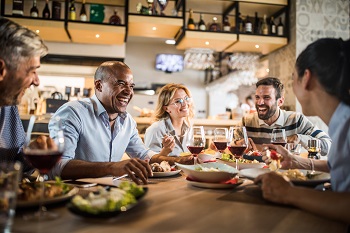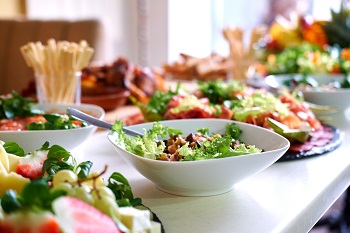 When you are first diagnosed with celiac disease the idea of eating outside your home can be uncomfortable or scary. And, in fact, it makes good sense to carefully prepare your gluten-free meals at home those first few months until you understand more about safe and unsafe ingredients, food labeling laws and how food is prepared in general.
When you are first diagnosed with celiac disease the idea of eating outside your home can be uncomfortable or scary. And, in fact, it makes good sense to carefully prepare your gluten-free meals at home those first few months until you understand more about safe and unsafe ingredients, food labeling laws and how food is prepared in general.
Cross-contamination can occur any place where food is served, including restaurants, diners, buffet lines, vendor carts, salad bars, in stores that use open bins and in airline food. It can occur any place where a variety of different meals are made, different ingredients come together, or the same equipment is used for both gluten-free and gluten-containing foods. Before you dine out, learn everything you can about what restaurants can do to help avoid cross-contamination. This knowledge will help you ask the right questions.
Eating Away from Home: The Basics
The average American eats out 4.2 meals per week, and knowing just the basics of a gluten-free diet makes dining away from home easier, less stressful and healthier.
- A good understanding of safe and unsafe ingredients will help you choose food more safely at restaurants, catered events, picnics, friends' houses, and parties, etc.
- Plan ahead and review a restaurant's menu for the safest choices.
- ALWAYS identify yourself as someone who needs a special diet. Do not try to guess if the menu item is safe.
- Ask your server, the manager or the chef clear questions about ingredients and the chance of cross-contamination. Cross-contamination can occur any place where food is served.
- Send back any food that is not gluten-free (such as croutons on your salad). Clearly explain the problem to the waitstaff so that it can be corrected and you can enjoy a safe meal. You deserve it!
- Bring along your own favorite gluten-free sauces or dressings to flavor your meal if needed.
- There are many resources for dining out gluten-free, including Restaurant Guides and Dining Cards. Show them to waiters to help them understand your gluten-free diet.
- Always travel with food so that you never go hungry!
- Click here to download the gluten-free snacking list.
- Don't let the gluten-free diet hold you back! A positive attitude and a game plan will help you dine out more safely.
- ALWAYS identify yourself as someone who needs a special diet. Do not try to guess if the menu item is safe.
- Learn about safe/unsafe ingredients and how food is prepared and cooked
Gluten-Free (GF) Food to Go:
- Dried fruit/trail mix labeled GF
- GF Muffins (in a container to avoid crumbling)
- Fresh fruit, veggies
- GF Cookies
- Plain nuts and seeds
- GF rice/corn cakes
- Dried GF cereal in bags
- GF Dried soups
- Tuna in a pouch (check ingredients)
- Packaged GF entrees
- Freeze-dried GF food
- Peanut butter
- GF Energy bars
- GF Chips
- Pre-toasted GF bread
- GF soy sauce, condiments
- GF Pretzels
- GF Protein powder (to mix with juice or milk)
 Easy Menu Items to Begin:
Easy Menu Items to Begin:
- Simply cooked foods without added sauces
- Salad with added grilled chicken or salmon. Choose oil and vinegar dressing (not malt vinegar). Ask your server to avoid serving you croutons, crackers, or bread. You can ask for more vegetables instead.
- Simply cooked seafood dishes, such as grilled scallops or shrimp with lemon, garlic and butter. Broiled or baked fish cannot be marinated or topped with bread or cracker crumbs, or sauce. Poached fish cannot be held in a gluten-containing broth. Lobster cannot be cooked in beer.
- Poultry or meat dishes cooked simply without marinades. Meat cannot be marinated prior to cooking, held in broth, or served with a sauce that contains gluten.
Speaking Up with Servers
Many people do not want to speak up for themselves or to draw attention to their special needs. They would rather try to make choices on what they think is safe vs. asking what is safe. The first step to safe dining is to identify yourself and ask questions. Remember that you are the one to pay the price if a mistake is made and you eat a gluten-containing food. It is your health and wellness that is at stake so do not hesitate to speak up.
- Know the gluten-free diet and the questions to ask.
- Do your homework before you go. Learn about the restaurant and what it offers. This can be done online or over the phone ahead of time.
- Identify yourself to the wait staff as someone on a special diet.
Anxiety about speaking up about food allergies and intolerances is a very common reason why people have reactions to food when dining out.
- Ask specific questions of your server or the chef (and ask again!) Be sure you are talking to someone who knows both the ingredients and how the food is prepared - this is generally the chef or the manager. See below (More Tips for Dining Out) for some helpful questions.
- When in doubt, choose a very simple meal with only a few ingredients.
- Do not accept mistakes. Send your food back if it is not gluten-free.
- Try to go early or late when it is not as busy for the wait staff.
- Say thank you and tip well!
- Read this handout on Dining Out on American Cuisine
More Tips for Dining Out
- Whenever possible, review the menu ahead of time. If it is a catered event (wedding, party or conference), contact the manager or head chef in advance for the menu. Get the name of the contact person at the event who will help you with your special meal.
- Then, have a conversation with a manager or chef who is very familiar with the menu. Ask:
- Do you regularly serve customers on the gluten-free diet?
- Which of your dishes are gluten-free?
- Which dishes are off-limits?
- Which dishes or items can be adjusted to accommodate my gluten-free diet?
- Ask if an item can easily be made or served gluten-free:
- Grilled or broiled fish WITHOUT bread crumbs
- Roast beef WITHOUT au jus (sauce)
- Vegetables cooked with herbs (instead of an unidentifiable seasoning blend)
- Vegetables steamed over clean, boiling water (instead of boiling pasta water)
- Very important: ask your server how the restaurant works to avoid cross-contamination, or cross-contact, of your meal with gluten-containing meals.
"Cross-contact" is a term, similar to cross-contamination, used in the food industry. It refers to when one food comes into contact with another one causing their proteins to mix. 4 You can use this term at the restaurant and it will be very familiar to the waiter, chef and manager.
Some examples to avoid cross-contact:
- Separate preparation area and utensils for gluten-free meals
- Use of a clean part of the grill or a separate skillet
- Fresh gloves
- Frequent hand washing
- Designated fryer versus shared fryer (chips and french fries may be cooked in contaminated oil used to cook flour-battered foods)
- Discuss your dietary needs with the chef/caterer and make selections in advance. If it is buffet-style, ask if the chef can set aside a plate for you with your name on it. You can identify yourself to the server.
- If you go through a buffet line, choose items that are obviously safe. Watch for serving utensils that may have traveled back and forth among dishes.
- Think about the kind of dining establishment you are in. Restaurants that make their own bread, pizzas, quiches, etc., are much more likely to have issues with cross-contamination through airborne and surface gluten exposure, especially if an entirely separate area for gluten-free food production is not available. If you have no other dining choice, a safer alternative is to come with your own bread, roll, or pizza wrapped in foil and ask for it to be heated without unwrapping it.
- Bring your own slice of gluten-free bread, roll, cookie, salad dressing, etc., to enhance your meal.
- If the desserts are limited, (i.e. wedding cake), ask:
- Can a substitution be made?
Examples: fresh fruit, ice cream, sorbet, creme Brule, frozen yogurt (check all ingredients first.)
- Do not go to the event hungry. Have a little snack before you leave to ward off temptation in case it is difficult to find something to eat.
Gluten-Free Dining While Traveling
Traveling beyond your own home or town can seem a bit daunting until you are more comfortable with your gluten-free diet. Fortunately, whether it is for work or fun, there are numerous ways to make life and eating easier on the road.
- Pack food that travels well.
- Accept that eating "on the go" is more costly and usually not as healthy.
- Prepare, prepare, prepare.
- Food is only one part of the puzzle. You are also going for the adventure and the people!
By Car:
- Take along an ice cooler filled with gluten-free deli meat, carrot sticks, cheese sticks, etc to eat at the beginning of your trip.1 Keep cold food properly refrigerated.
- Click here to download "Gluten Free Snack Food Shopping List" for more great ideas!
- Carry shelf-staple essentials along with you, as well: plain gluten-free chips and rice/corn cakes, peanut butter, gluten-free energy bars, etc. Gluten-Free Food to Go chart
- Check out the resources below to find "celiac-friendly" dining stops and use AAA maps, mapquest.com, googlemaps.com, etc to plot them.
By Plane, Train or Bus:
- Pre-order a gluten-free meal on airlines (if available).
Few domestic airlines offer special meals these days; you may find the fruit and cheese platter to be the safest (avoid crackers). Some longer flights may offer gluten-free meals but they are pre-made so call in advance. If you have ordered a meal let the flight attendant know as soon as you board so your meal is not delivered to someone else.
- THINK Airport security - no knives, water, liquid, or peanut butter are allowed as a carry-on.
- Buy drinks, yogurt, etc after going through security.
- Pack extra food as "back-up" in case you are stuck in long lay-overs in terminals or train stations or cannot find food conveniently when you first arrive. Bus pit-stops may have very few options.
- Pack non-smelly, easy to carry food.
- Carry your gluten-free medications and supplements with you in case you are separated from your luggage.
In Your Lodging:
- Before leaving home, check on nearby dining out options.
- Ask "local support groups" and the concierge/front desk for ideas and resources.
- Book a room with a kitchenette or at least a mini-fridge.
- If none, ask the hotel to hold food for you - they may do this in some cases.
Click here to download a helpful travel article
Gluten-Free Dining While Traveling Abroad

Much of the world does not rely as heavily on wheat and wheat-based food as the United States. You can find delicious, healthy and naturally gluten-free foods made of rice, corn, teff, quinoa, sorghum, millet, potatoes and other grains and starches in recipes from all over the world.
By asking a few questions about ingredients and cross contamination in ethnic restaurants (Japanese, Thai, Indian, Malaysian, Italian, Vietnamese and many more), a wide selection of new food can be yours.
- Request a gluten-free meal on your international flight(s) weeks ahead and reconfirm shortly before your trip.
- Check out each country's celiac website for restaurants, grocery stores and pharmacies.
- Carry gluten-free restaurant cards in the languages of the countries you are visiting 2
- Carry a medical letter of necessity stating you have a dietary restriction (for items you carry in your suitcase such as sealed gluten-free pasta and crackers) in case you are questioned by the Customs Department.
These handouts may be helpful to you when you choose ethnic cuisine:
Revision Date: March 16, 2021
Author: Melinda Dennis, MS, RD, LDN
Editors: Pam Cureton, RD, LDN and Daniel Leffler, MD, MS
CeliacNow Disclaimer
 When you are first diagnosed with celiac disease the idea of eating outside your home can be uncomfortable or scary. And, in fact, it makes good sense to carefully prepare your gluten-free meals at home those first few months until you understand more about safe and unsafe ingredients, food labeling laws and how food is prepared in general.
When you are first diagnosed with celiac disease the idea of eating outside your home can be uncomfortable or scary. And, in fact, it makes good sense to carefully prepare your gluten-free meals at home those first few months until you understand more about safe and unsafe ingredients, food labeling laws and how food is prepared in general. Easy Menu Items to Begin:
Easy Menu Items to Begin:
